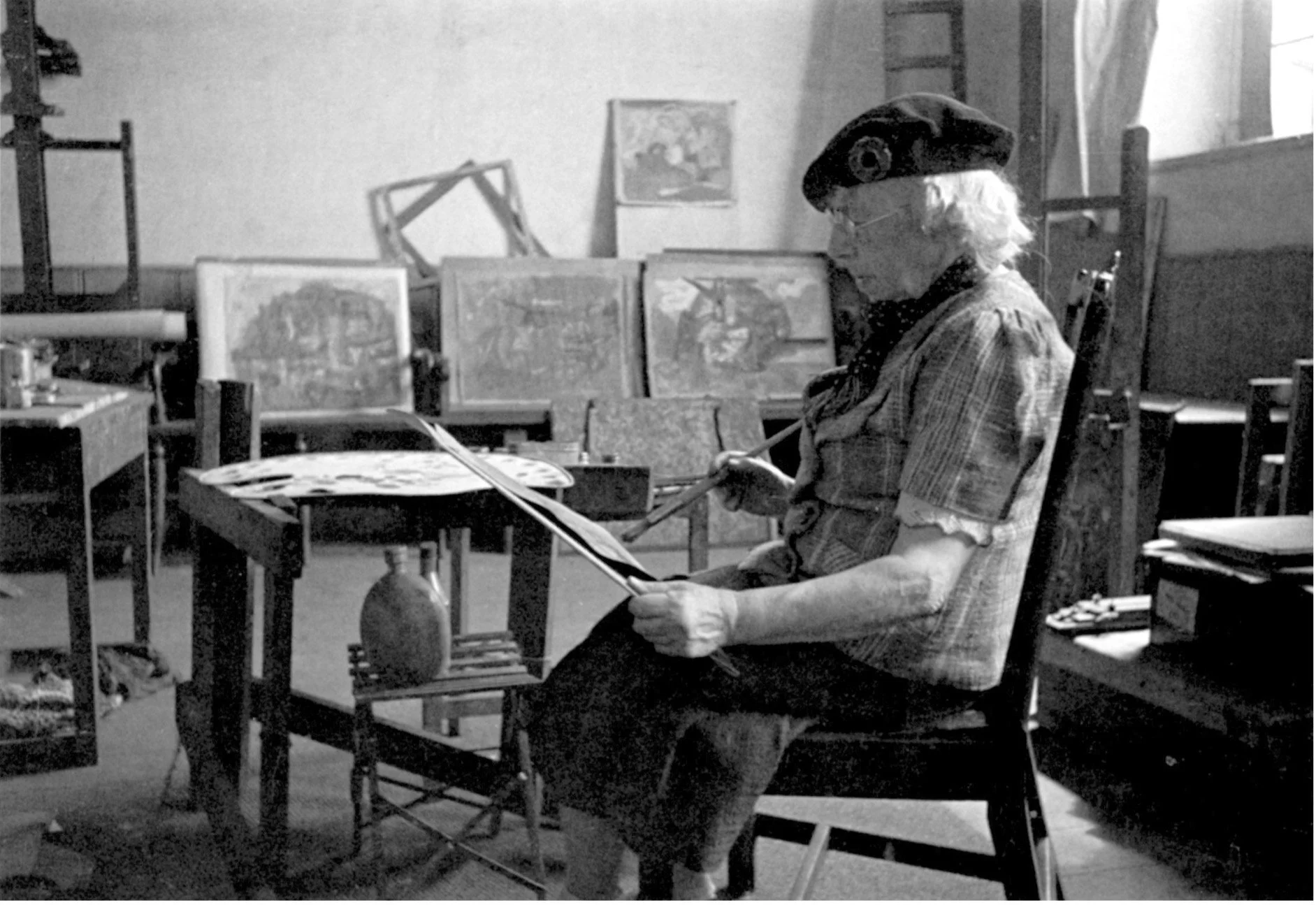Frances Hodgkins and The Greyhound Inn, Corfe Castle
The Greyhound Inn sits below the remains of the Outer Bailey wall of Henry the First’s Corfe Castle between the Outer Gatehouse and the Horseshoe Tower which were added between 1280 and 1285. It was originally a 17th century coaching inn called the Black Dog and its porch bears the inscription I.C. 1733 this being the initials of the then owner, John Cockram.
In 1919 Francis Newbury, the retired director of the Glasgow School of Art, and his wife Jessie moved to Corfe Castle and lived at the Greyhound Inn for two years prior to purchasing a house in East St and also buildings in West St. There he turned an old Weslyan Chapel into a studio and renovated a group of cottages, which in 1934 would become Frances Hodgkins’ studio and the cottage next door, her home in 1941.
During the 1940s the licensee of the Greyhound was Arthur Hobbs, a retired merchant seaman who was assisted by his wife Kathleen and her sister.
Frances Hodgkins made the West Street studio and cottage her base although she continued to travel extensively until the outbreak of the Second World War. During the war years Corfe Castle village was a terrifying cacophony of tanks, lorries, field guns, and troops on their way to the coast through the narrow streets by day. At night German bombers terrorised the coast returning from their raids on England’s industrial cities, while Allied aircraft flew overhead bringing the wounded back from Normandy.
In 1944 Hodgkins was clearly feeling the effects of wartime sanctions on the highly militarised Dorset coast of Purbeck. Reflecting on her wartime experience she wrote, “this has scared all art out of me. I simply cannot paint”. The previous year the rumbling tank movements through the village had caused the roof to fall off her studio, and now a big chunk of the Greyhound wall had been knocked off, but she nevertheless suggested on different occasions to both Cedric Morris and Dorothy Selby that they come down to the Greyhound to escape the ravages of bombing in London, but it appeared there was no room to be found for casual visitors.
Travel to her favourite painting spots along the coastline was banned. Food was in very short supply, and she regularly swapped her sugar ration with her friend Amy Krauss for seasonal fruit and vegetables from Amy’s garden.
In her increasingly nervous state, Frances moved into the Greyhound in June 1944. Writing to her brother William Hodgkins “feeding myself and running my small cottage under great difficulties. I reached point of saturation so came to the Greyhound where I now am, for company’s sake as much as anything - I get three good meals a day. I have taken the greatest pleasure in sharing my precious cheese with the soldiers and their wives at the inn - it is only a small hostel with a few stuffy noisy bedrooms (convoys of tanks etc make hellish noise passing up and down in and out of the village) For a shilling there is a hot bath - you have to ask the landlady for the plug and key of bathrooms - But it works & the water is good and hot… I live from hour to hour - day-to-day - this new Pilot horror (V1 guided missiles) makes us feel rather desperate especially at nights - overhead both day and night doing their damnedest to keep one awake & guessing - you no doubt wonder why I stay? So do I!... Friends here are good to me & the country is lovely and this bit of the coastline in Dorset the loveliest in the world - banned now of course. I am in fairly good health and am feeling the benefit of regular meals - and more rest. Most of us are looking rather wan - one needs to be pretty strong headed to survive a 4 yrs. war such as this war. Don't be anxious about me - I am alright so long as you continue to get papers from me – I am glad you enjoy them. Have plenty of work to do for the Galleries. I am delighted with invitations commissions etc. They all want Frances H now.”
In 1945 Frances Hodgkins was part of an exhibition at the Lefevre Gallery, London, including Henry Moore, Matthew Smith, Graham Sutherland, and Francis Bacon. Eardley Knollys proposed a celebratory party, which she declined to attend saying in her unpretentious manner “I am immensely conscious of all I shall miss at your dazzling party given in honour of a dilapidated artist from the slums of Dorset”. In November 1946 Hodgkins had a retrospective exhibition of 79 works from 1902 to 1946 at the Lefevre Gallery. The exhibition was an outstanding critical success. Art critic M.H. Middleton of The Spectator described her as “one of the most remarkable women painters of our own or any country of our own or any time”. On the last day of the exhibition Amy Krauss took Frances to see her exhibition and as she was walked through by the gallery director, Duncan Macdonald, she was thrilled to be reunited with so many memorable scenes from her lifetime.
In the spring of 1946 Hodgkins told her friend Jane Saunders that she was suffering from a “bit of a breakdown” and her work, of necessity, “had slowed down, if not actually stopped”. As she became more frustrated with her failing eyesight and her lack of mobility, her mental and physical health deteriorated, and Mrs Hobbs was no longer able to care for her needs at the Greyhound. Hodgkins was admitted to Herrison House Hospital near Dorchester on March 22nd 1947 and a few weeks after her 78th birthday, on the 13th of May, Frances Hodgkins died there. Her death was announced on the BBC nine o’clock news on 14th May.





